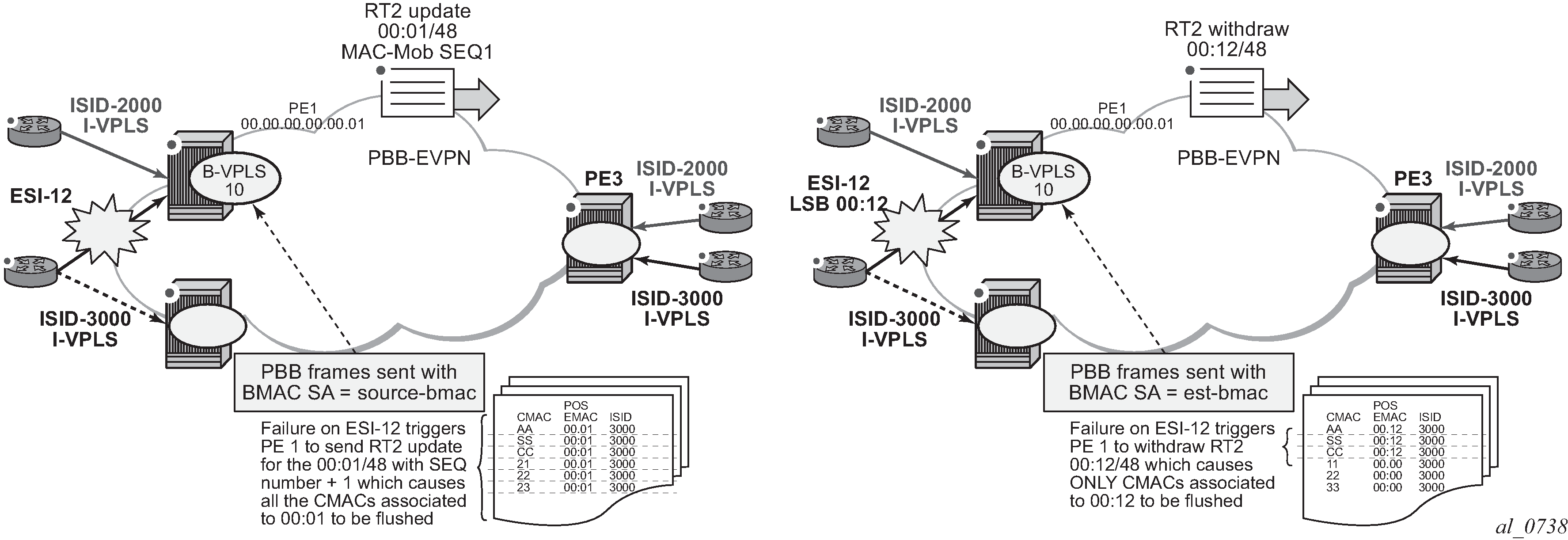In single-active multihoming, the non-DF PEs for a specified ESI block unicast and BUM traffic in both directions (upstream and downstream) on the object associated with the ESI. Other than that, single-active multihoming follows the same service model defined in the PBB-EVPN all-active multihoming service model section with the following differences:
The ethernet-segment is configured for single-active: service>system>bgp-evpn>eth-seg>multi-homing single-active.
For single-active multihoming, the ethernet-segment can be associated with a port and sdp, as well as a lag.
From a service perspective, single-active multihoming can provide redundancy to the following services and access types:
I-VPLS LAG and regular SAPs
I-VPLS active/standby spoke SDPs
EVPN single-active multihoming is supported for PBB-Epipes only in two-node scenarios with local switching.
While all-active multihoming only uses es-bmac assignment to the ES, single-active multihoming can use source-bmac or es-bmac assignment. The system allows the following user choices per B-VPLS and ES:
A dedicated es-bmac per ES can be used. In that case, the pbb use-es-bmac command is configured in the B-VPLS and the same procedures described in PBB-EVPN all-active multihoming service model follow with one difference. While in all-active multihoming all the PEs part of the ESI source the PBB packets with the same source es-bmac, single-active multihoming requires the use of a different es-bmac per PE.
A non-dedicated source-bmac can be used. In this case, the user does not configure pbb>use-es-bmac and the regular source-bmac is used for the traffic. A different source-bmac has to be advertised per PE.
The use of source-bmacs or es-bmacs for single-active multihomed ESIs has a different impact on C-MAC flushing, as shown in Figure 1.
Figure 1. Source-bmac versus es-bmac C-MAC flushing
If es-bmacs are used as shown in the representation on the right in Figure 1, a less-impacting C-MAC flush is achieved, therefore, minimizing the flooding after ESI failures. In case of ESI failure, PE1 withdraws the es-bmac 00:12 and the remote PE3 only flushes the C-MACs associated with that es-bmac (only the C-MACs behind the CE are flushed).
If source-bmacs are used, as shown on the left side of Figure 1, in case of ES failure, a BGP update with higher sequence number is issued by PE1 and the remote PE3 flushes all the C-MACs associated with the source-bmac. Therefore, all the C-MACs behind the PE's B-VPLS are flushed, as opposed to only the C-MACs behind the ESI's CE.
As in EVPN-MPLS, the non-DF status can be notified to the access CE or network:
LAG with or without LACP: in this case, the multihomed ports on the CE are not part of the same LAG. The non-DF PE for each service may signal that the LAG SAP is operationally down by using eth-cfm fault-propagation-enable {use-if-tlv|suspend-ccm}.
Regular Ethernet 802.1q/ad ports: in this case, the multihomed ports on the CE/network are not part of any LAG. The non-DF PE for each service signals that the SAP is operationally down by using eth-cfm fault-propagation-enable {use-if-tlv|suspend-ccm}.
Active-standby PWs: in this case, the multihomed CE/network is connected to the PEs through an MPLS network and an active/standby spoke SDP per service. The non-DF PE for each service makes use of the LDP PW status bits to signal that the spoke SDP is standby at the PE side. Nokia recommends that the CE suppresses the signaling of PW status standby.